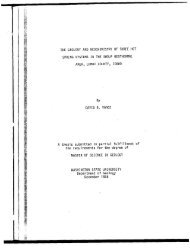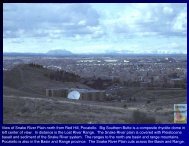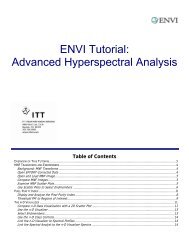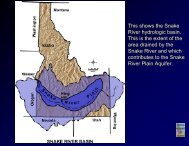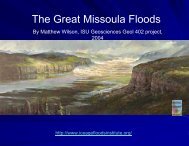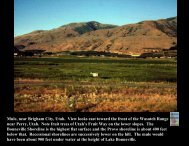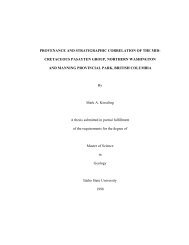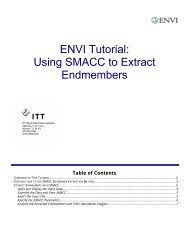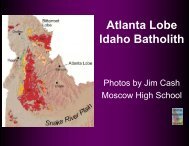Print the questions and the map. They are in the same pdf document.
Print the questions and the map. They are in the same pdf document.
Print the questions and the map. They are in the same pdf document.
Create successful ePaper yourself
Turn your PDF publications into a flip-book with our unique Google optimized e-Paper software.
Magic Gulch Water <strong>and</strong> Waste Problem<br />
NAME: ________________<br />
The attached <strong>map</strong> illustrates <strong>the</strong> confluence of two streams near a small rural<br />
development called Magic Gulch. Contours on <strong>the</strong> <strong>map</strong> <strong>are</strong> estimated levels of <strong>the</strong><br />
water table (WT). The water table level at 1100m near <strong>the</strong> south edge of Magic<br />
Gulch community represents <strong>the</strong> ambient WT <strong>in</strong> a regional, fairly homogeneous,<br />
aquifer which lies beneath <strong>the</strong> town. The current water supply is WELL #1. In <strong>the</strong><br />
early 1900's, a small m<strong>in</strong>e was operated <strong>in</strong> <strong>the</strong> southwest part of <strong>the</strong> <strong>map</strong>. The<br />
m<strong>in</strong>ers also used a nearby pit as a dump for about 30 years before <strong>the</strong> m<strong>in</strong>e shut<br />
down. All operational refuse went <strong>in</strong>to <strong>the</strong> dump <strong>and</strong> a pile of m<strong>in</strong>e tail<strong>in</strong>gs<br />
(crushed rock) is located at <strong>the</strong> m<strong>in</strong>e entrance.<br />
City planners <strong>in</strong> Magic Gulch obta<strong>in</strong>ed water tests from WELL #1 <strong>and</strong> found it to<br />
conta<strong>in</strong> excessive levels of z<strong>in</strong>c, cadmium <strong>and</strong> copper (among o<strong>the</strong>r constituents),<br />
so <strong>the</strong>y want to drill a new town well at <strong>the</strong> WELL #2 site. Hydrologists suggest<br />
that pump<strong>in</strong>g <strong>the</strong> <strong>same</strong> amount of water from WELL #2 as <strong>the</strong>y <strong>are</strong> currently<br />
pump<strong>in</strong>g from WELL #1 will create a cone of depression that is 100 meters <strong>in</strong><br />
diameter after equilibrium is reached dur<strong>in</strong>g cont<strong>in</strong>ual pump<strong>in</strong>g.<br />
EXERCISE -- Draw on <strong>the</strong> attached <strong>map</strong> <strong>and</strong> answer <strong>questions</strong> on this page. Use<br />
<strong>the</strong> backside for additional space.<br />
1. Draw water table flow l<strong>in</strong>es from each of five po<strong>in</strong>ts (A-E) on <strong>the</strong> <strong>map</strong> to<br />
produce a simple flow net of <strong>the</strong> <strong>are</strong>a.<br />
2. What is <strong>the</strong> average WT gradient between <strong>the</strong> m<strong>in</strong>e <strong>and</strong> <strong>the</strong> river<br />
3. Us<strong>in</strong>g <strong>the</strong> data available, determ<strong>in</strong>e <strong>the</strong> velocity of contam<strong>in</strong>ants (leachate) from<br />
<strong>the</strong> m<strong>in</strong>e through <strong>the</strong> groundwater system once <strong>the</strong>y have reached <strong>the</strong> saturated<br />
zone.<br />
4. Once any new leachate from <strong>the</strong> m<strong>in</strong>e <strong>in</strong>filtrates to <strong>the</strong> saturated zone, how long<br />
does it take for it to reach <strong>the</strong> river<br />
5. Well #1 is across <strong>the</strong> river from <strong>the</strong> m<strong>in</strong>e. What hydrologic reason(s) <strong>are</strong> <strong>the</strong>re to<br />
suspect m<strong>in</strong>e waste as <strong>the</strong> source of potential contam<strong>in</strong>ants <strong>in</strong> <strong>the</strong> well water<br />
6. What is <strong>the</strong> average WT gradient <strong>and</strong> velocity of groundwater between <strong>the</strong> dump<br />
<strong>and</strong> <strong>the</strong> river How long would it take for dump leachate to reach <strong>the</strong> river once it<br />
is <strong>in</strong> <strong>the</strong> saturated zone
7. Is <strong>the</strong> new well a good site for <strong>the</strong>ir water supply Why or why not Answer <strong>in</strong><br />
terms of <strong>the</strong> distance from estimated flow l<strong>in</strong>es to <strong>the</strong> cone of depression <strong>and</strong> <strong>the</strong><br />
likelihood of chemical dispersion.<br />
8. What additional <strong>in</strong>formation would be useful to evaluate this problem<br />
MAGIC GULCH MAP



